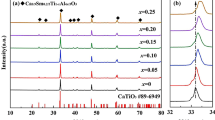Abstract
A novel CaxY3−xAl5−xTixO12 (0 ≤ x ≤ 2.0) solid solution with garnet structure was synthesized by solid-state reaction technique. Ca2+ and Ti4+ substituted for Y3+ and Al3+, respectively. Ca2+/Ti4+ doping reduced the sintering temperature of CaxY3−xAl5−xTixO12 ceramics to 1450 °C, and it also improved corresponding densification process. Meanwhile, the doping strongly influenced microwave dielectric properties. For the samples sintered at 1550 °C for 3 h, the dielectric constant (εr) increased from 7.2 to 34.7 by increasing Ca2+/Ti4+ content, and at the same time the quality factor (Q × f) values increased from 12,000 to 45,200 GHz and then slightly declined to 41,000 GHz. The temperature coefficient of resonant frequency (τf) values of these samples increased monotonically from − 40 to + 31 ppm/°C by increasing Ca2+/Ti4+ content. Therefore, CaxY3−xAl5−xTixO12 solid solution ceramics with x = 1.5 sintered at 1550 °C for 3 h showed optimum microwave dielectric properties: εr = 32.6, Q × f = 45,200 GHz and τf = + 7 ppm/°C. CaxY3−xAl5−xTixO12 (0 ≤ x ≤ 2.0) solid solution ceramics with garnet structure were new promising aluminate ceramics for microwave dielectric application.










Similar content being viewed by others
References
P. Wang, Y.R. Wang, J.X. Bi et al., J. Alloys Compd. 721, 143–148 (2017)
B. Tang, S. Yu, H. Chen et al., J. Alloys Compd. 551, 463–467 (2013)
S. Takahashi, H. Ogawa, A. Kan, J. Eur. Ceram. Soc. 38, 593–598 (2018)
B. Tang, S. Yu, H. Chen et al., J. Mater. Sci. Mater. Electron. 24, 1475–1479 (2013)
S. Yu, S. Zhang, B. Tang et al., Ceram. Int. 38, 613–618 (2012)
K.P. Surendran, N. Santha, P. Mohanan, Eur. Phys. J. B 41, 301–306 (2004)
C.W. Zheng, S.Y. Wu, X.M. Chen et al., J. Am. Ceram. Soc. 90, 1483–1486 (2007)
J.M. Wu, W.Z. Lu, W. Lei et al., Mater. Res. Bull. 46, 1485–1489 (2011)
M.H. Kim, C.S. Woo, S. Nahm et al., Mater. Res. Bull. 37, 605–615 (2002)
C. Huang, X. Lu, M. Lu et al., Ceram. Int. 43, 10624–10627 (2017)
A. Ikesue, Y.L. Aung, J. Am. Ceram. Soc. 100, 26–30 (2017)
I. Kagomiya, Y. Matsuda, K. Kakimoto et al., Ferroelectrics 387, 1–6 (2009)
W. Jin, W. Yin, S. Yu et al., Mater. Lett. 173, 47–49 (2016)
X. Zhang, X. Wang, P. Fu et al., Ceram. Int. 41, 7783–7789 (2015)
X. Zhang, G. Fan, W. Lu et al., J. Eur. Ceram. Soc. 36, 2767–2772 (2016)
Y. Zhou, Z. Yue, L. Li, Ferroelectrics 407, 69–74 (2010)
B.W. Hakki, P.D. Coleman, IRE Trans Microw. Theory Tech. 8, 402–410 (1960)
S. Kostić, Z. Lazarević, V. Radojević et al., Mater. Res. Bull. 63, 80–87 (2015)
R.D. Shannon, J. Appl. Phys. 73, 348 (1993)
Y.J. Lin, S.F. Wang, B.C. Lai et al., J. Eur. Ceram. Soc. 37, 2825–2831 (2017)
Acknowledgements
This work was supported by the national natural science foundation of China (Grant Nos. 61672356, 51702301), the Scientific Research Fund of Hunan Provincial Education Department (Grant No. 08C786), the Aid program for Science and Technology Innovative Research Team in Higher Educational Institutions of Hunan Province and the Key Laboratory of Science and Technology on High Energy Laser, CAEP.
Author information
Authors and Affiliations
Corresponding author
Rights and permissions
About this article
Cite this article
Peng, S., Zhao, C., Huang, G. et al. Crystal structure, sintering behavior and microwave dielectric properties of CaxY3−xAl5−xTixO12 (0 ≤ x ≤ 2.0) solid solution ceramics. J Mater Sci: Mater Electron 29, 17047–17053 (2018). https://doi.org/10.1007/s10854-018-9801-x
Received:
Accepted:
Published:
Issue Date:
DOI: https://doi.org/10.1007/s10854-018-9801-x




